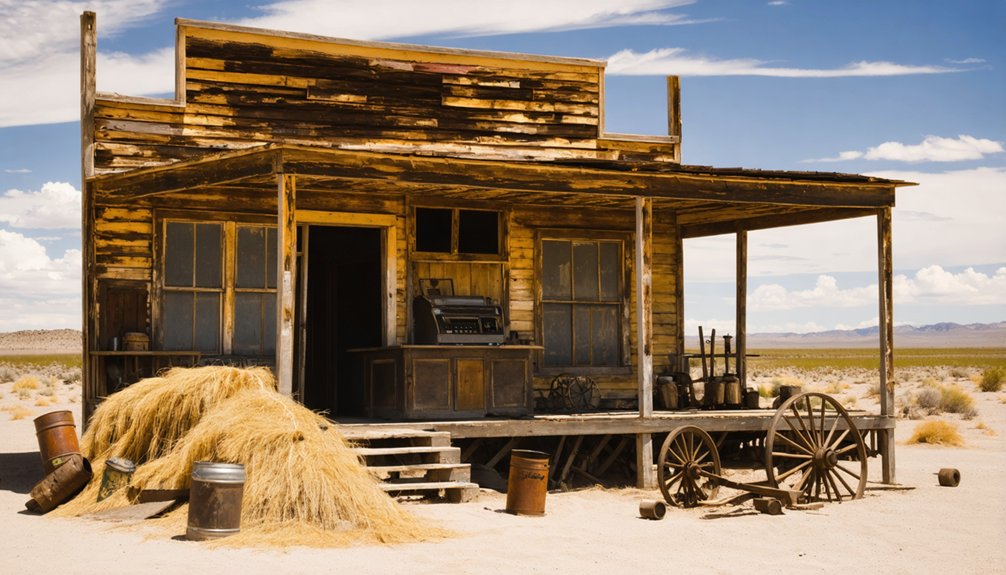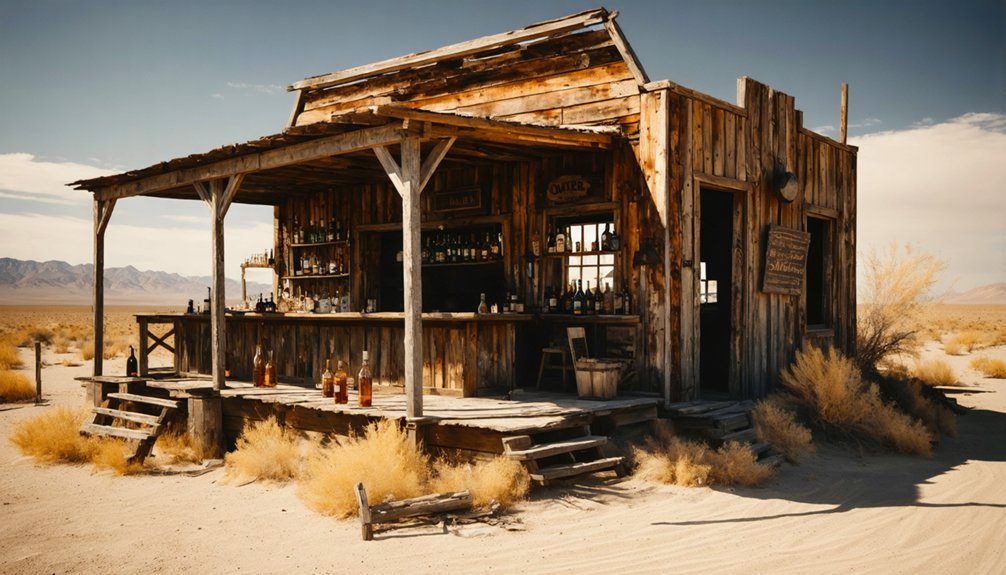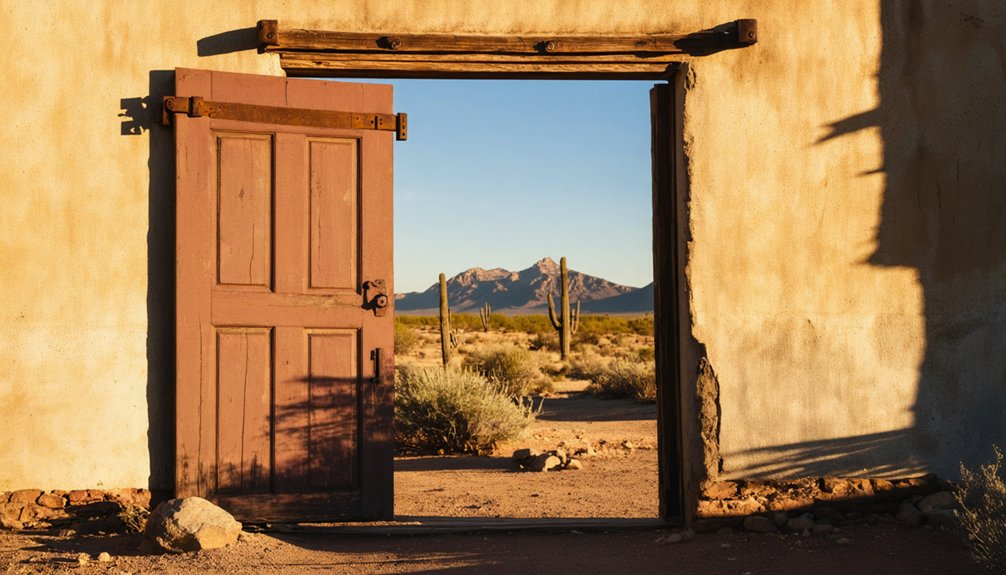You’ll find Adamsville’s ghost town ruins two miles west of Florence, Arizona, along State Route 287. Founded in 1866 by Charles S. Adams, this once-thriving frontier settlement boasted innovative irrigation systems and an essential flour mill. Despite early agricultural success, the town faced devastating floods, including a catastrophic 1900 deluge that destroyed most adobe structures. Today, you can explore the historic Butte View Cemetery and mill ruins, where desert winds whisper tales of frontier ambition and ultimate abandonment.
Key Takeaways
- Adamsville ghost town lies two miles west of Florence, Arizona, marked by adobe ruins and the historic Butte View Cemetery.
- Founded in 1866 by Charles S. Adams, the town thrived on agriculture until devastating floods and economic challenges led to its abandonment.
- The town’s demise began with the 1871 burning of its vital flour mill, followed by destructive floods in 1873, 1884, and 1900.
- Historical landmarks include a preserved cemetery with 80 marked graves and remnants of the town’s water infrastructure and mill ruins.
- Added to the National Register of Historic Places in 1970, the site remains accessible via State Route 287 and East Adamsville Road.
The Birth of a Frontier Settlement
When Charles S. Adams founded Adamsville in 1866, he embodied the pioneering spirit that drove westward expansion after the Civil War. As a former Union Army officer, he recognized the untapped potential of the Gila River valley in what was then Pima County, Arizona Territory.
You’ll find that Adams’s choice of location proved strategic, as the site offered both fertile soil and a natural river crossing. His agricultural innovation built upon the legacy of ancient Hohokam canals, establishing new irrigation systems that transformed the desert into productive farmland. The town’s development accelerated with the establishment of a post office in 1871.
Early settlers quickly joined him, drawn by the promise of cultivating wheat, corn, and cotton using the life-giving waters of the Gila River. The settlement’s initial success reflected the determination of frontier farmers to carve out a new life in the untamed Arizona Territory. The community thrived with the construction of a flour mill and several general stores.
Life Along the Gila River
Along the Gila River, you’d find a complex network of indigenous settlements where the Akimel O’odham and Maricopa peoples maintained over 200 miles of irrigation canals for their agricultural needs.
You’ll notice how these communities worked together, sharing both the responsibilities of canal maintenance and the rewards of successful farming through established social cooperation.
While the river provided sustenance through agriculture, you’d also discover its spiritual significance to the indigenous peoples, who considered the waterway sacred and incorporated it into their daily cultural practices.
The ancestral Huhugam people constructed an impressive network of over 500 miles of canals, supporting a thriving population of up to 60,000 during their peak around 1150-1450 CE.
The four thousand inhabitants of these villages along the Gila River produced massive agricultural yields, including over 13,000 tons of corn and wheat annually.
River Settlement Challenges
The settlers’ encroachment on Pima tribal lands after the Civil War marked the beginning of a devastating water crisis along the Gila River. As newcomers diverted water upstream, you’d find the once-thriving Pima agricultural communities driven into poverty and famine.
Key challenges that emerged during settlement disputes included:
- Illegal diversions by non-Indian users leading to widespread malnutrition
- Decades-long legal battles over water rights claims
- The need to use reclaimed wastewater for agriculture
- Persistent conflicts between tribal and non-tribal water users
The Pima people had developed complex irrigation systems that sustained their agriculture before colonial settlement disrupted their way of life.
While the 2004 Arizona Water Settlements Act granted the Gila River Indian Community 653,500 acre-feet annually, you’ll find that uncertainty remains.
The Community had to waive future litigation rights, leaving them vulnerable if drought conditions worsen.
The Lunt family has witnessed over a century of these water disputes since establishing their homestead along the river in 1917.
Early Agricultural Development
Settlers in Adamsville found innovative ways to overcome their water challenges by tapping into ancient wisdom. They cleverly adapted Hohokam canal alignments and partnered with Akimel O’odham workers to construct irrigation systems that blended indigenous engineering with American farming practices.
You’ll find their irrigation techniques reflected a practical fusion of old and new methods, as they quickly dug ditches along the Gila River to support their growing farms. The 500 miles of canals built by ancient Huhugam peoples served as inspiration for these new irrigation efforts. By the 1870s, wheat production had become the primary cash crop for local farmers.
The settlers embraced crop diversity, cultivating traditional staples like corn, beans, and squash while adding cotton and tobacco to their agricultural portfolio. By the late 19th century, this agricultural innovation paid off – Pinal County saw property values soar by 312 percent.
However, their success came at a cost to indigenous farmers, whose irrigated acreage dropped dramatically to 3,600 acres by 1900.
The Mill That Put Adamsville on the Map
You’ll find the Pioneer Valley’s first flour mill in Adamsville, built by the Bichard Brothers in 1871 during the town’s early growth along the Gila River.
The Fred Adams settlement became home to numerous businesses and residences after its founding in 1870.
After experiencing a devastating flood in 1900, most residents abandoned Adamsville and relocated to the nearby town of Florence.
The mill achieved historical significance by producing the Valley of the Sun’s first flour on July 4, 1871, marking a pivotal moment for regional agriculture and commerce.
Your understanding of the mill’s impact deepens with the knowledge of its suspicious destruction by fire just two months later on September 2, resulting in a substantial $10,000 loss – equivalent to about $232,558 today.
Pioneer Valley’s First Mill
Founded by the Bichard Brothers after Fred A. Adams departed Adamsville, the region’s first flour mill opened on July 4, 1871, marking a significant milestone in pioneering agriculture.
You’ll find this mill wasn’t just a business – it became the heart of the community’s resilience and economic growth.
The mill’s impact on Adamsville was remarkable, though short-lived:
- Served as the economic and social center, with stores and facilities supporting local farmers
- Enabled local agricultural production and flour distribution to Phoenix
- Adapted ancient Hohokam canal systems for innovative irrigation
- Drew on indigenous Akimel O’odham labor and agricultural knowledge
Tragically, the mill’s success lasted only two months before arson destroyed it on September 2, 1871, causing $10,000 in damages.
While William Bichard continued selling remaining flour stocks in Phoenix, the mill was never rebuilt.
Historic $10,000 Fire Loss
The devastating fire that consumed Adamsville’s flour mill on September 2, 1871, brought a staggering $10,000 loss – equivalent to roughly $232,558 in today’s currency.
The suspected arson not only destroyed the town’s first mill but also shattered the economic foundation of this frontier settlement. You’ll find it remarkable that the mill had operated for merely two months, having produced its first flour on July 4th of that year.
The economic consequences rippled through the community as William Bichard, rather than rebuilding, resorted to selling previously milled flour through retail operations.
Despite the community’s resilience, the mill’s destruction marked the beginning of Adamsville’s decline, ultimately contributing to its transformation into a ghost town by the 1920s.
Mill’s Suspicious Demise 1871
Standing at the heart of Adamsville’s economic aspirations, the Bichard Brothers’ flour mill marked a pivotal moment in Arizona Territory history when it produced its first flour on July 4, 1871.
However, you’ll find its promising future was cut tragically short when the mill burned to the ground on September 2, just two months after opening. The arson investigation revealed troubling signs of community tensions, though no definitive proof was ever found.
The mill’s destruction had far-reaching consequences:
- Financial loss of $10,000 (equivalent to $232,558 today)
- Derailed Adamsville’s economic momentum
- Forced William Bichard to relocate his flour business to Phoenix
- Contributed to the town’s eventual decline
This devastating event highlighted the precarious nature of frontier enterprises in a community already struggling with violence and instability.
Wild West Culture and Daily Life

Life in Adamsville epitomized the harsh realities of America’s Wild West, where violence and lawlessness shaped daily existence. You’d witness shootings and knifings regularly in this frontier town, where life was held cheap and frontier justice was often delivered at gunpoint.
Despite the constant threat of violence, community resilience emerged through the town’s essential institutions.
Your daily routine would revolve around the flour mill, the Valley of the Sun’s first, where local farmers brought their grain after irrigating their fields from the Gila River ditch.
You’d live in an adobe home, shop at one of the few general stores, and collect mail from the post office that operated until 1876.
The Ancient Order of United Workmen’s cemetery served as a gathering place, reflecting the town’s small but connected population.
Natural Forces and Town Destruction
While residents of Adamsville carved out their daily existence amid frontier challenges, nature ultimately proved to be the town’s most formidable adversary.
The settlement’s location on the Gila River’s floodplain, while initially advantageous for irrigation and farming, became its downfall. Despite local awareness of flood risks and attempts at environmental adaptation, the town’s infrastructure couldn’t withstand the river’s power.
Key factors that sealed Adamsville’s fate:
- Major floods in 1873 and 1884 devastated crops and irrigation systems
- The catastrophic 1900 flood destroyed most adobe structures
- Lack of flood management techniques left buildings vulnerable
- Arizona’s unpredictable desert climate created sudden, destructive river overflows
Exploring the Ghost Town Today

Located approximately two miles west of Florence, Arizona, today’s Adamsville ghost town offers history enthusiasts a glimpse into Arizona’s territorial past.
You’ll find the site easily accessible via State Route 287 and East Adamsville Road, where a historic marker greets visitors at the Florence-Coolidge Highway intersection.
During your historical exploration, you’ll discover the old flour mill, water tanks, and scattered adobe ruins.
Weathered adobe walls and remnants of frontier industry tell tales of Arizona’s pioneering spirit at historic Adamsville.
The crown jewel of your ghost town photography experience will be the well-preserved Butte View Cemetery, featuring about 80 marked graves dating back to the 1860s and protected by a wrought iron fence.
The site’s quiet, rural atmosphere and minimal development create an authentic backdrop for experiencing Arizona’s pioneer heritage.
Florence’s nearby amenities provide convenient support for your visit to this historic location.
Historical Recognition and Preservation
Recognizing Adamsville’s pioneering significance, the National Register of Historic Places added this early Pinal County settlement to its registry in 1970.
Historical markers along State Route 287 now commemorate the town’s legacy, while preservation efforts focus primarily on the Butte View Cemetery, the most tangible remnant of this once-thriving community.
You’ll find evidence of local dedication to historical preservation through:
- Cemetery restoration in the 1990s, including new wrought iron fencing
- Maintenance projects carried out by Boy Scouts and community groups
- Documentation of approximately 80 marked graves dating to the 1860s
- Protection of surviving infrastructure remnants, including water towers
The cemetery stands as a memorial to Adamsville’s pioneers, preserving their stories through carefully maintained grave markers that span the settlement’s active years.
Legacy of a Lost Arizona Town

Though Adamsville’s physical structures have largely vanished, the town’s pioneering legacy endures as a symbol of early Arizona Territory settlement.
Despite its physical absence, Adamsville’s spirit lives on through its role in shaping Arizona’s early territorial history.
You’ll find its cultural heritage reflected in the remaining Adamsville Cemetery, where graves from the 1870s tell stories of the frontier families who shaped this agricultural community.
The town’s economic impact on the region can’t be understated – it hosted the Valley of the Sun’s first flour mill and established essential irrigation systems that influenced later farming settlements.
While floods and lawlessness ultimately led to its downfall, Adamsville’s inclusion in the National Register of Historic Places preserves its significance in Arizona’s development.
The town’s brief but influential existence demonstrates both the promise and perils of frontier settlement in the American Southwest.
Frequently Asked Questions
Were Any Notable Outlaws or Lawmen Associated With Adamsville’s Violent History?
You won’t find major outlaw encounters or lawman legends in Adamsville’s history. Local sheriff Paul Hughes occasionally patrolled, but the town saw only minor crimes and typical mining camp violence.
What Native American Tribes Originally Inhabited the Area Around Adamsville?
You’ll find the Akimel O’odham (Pima) and Piipaash (Maricopa) tribes dominated the area’s tribal history, maintaining significant cultural significance through their advanced irrigation systems and agricultural practices along the Gila River.
How Many People Lived in Adamsville During Its Peak Population?
You’ll find that population statistics indicate 400-500 residents at the town’s peak in the 1870s, with town demographics showing mostly white settlers during this period of agricultural development.
Are There Any Paranormal Stories or Legends Associated With Adamsville?
Where there’s smoke, there’s fire – you’ll find numerous ghost sightings reported at Adamsville Cemetery and haunted locations throughout the flood-ravaged town, tied to its violent past and the tragic 1900 disaster.
What Happened to Fred Adams After the Town’s Decline?
After the 1900 flood, you’ll find Fred Adams lived ten more years in nearby Florence until his death in 1910. His legacy lives on through his burial in Adamsville’s A.O.U.W. Cemetery.
References
- http://www.ghosttownaz.info/adamsville-ghost-town.php
- https://azgw.org/pinal/ghosttowns.html
- https://www.youtube.com/watch?v=JFS9CsUKpn8
- https://www.ghosttowns.com/states/az/adamsville.html
- https://www.hmdb.org/m.asp?m=26805
- https://commons.wikimedia.org/wiki/File:Florence-Adamsville_Ghost_Town-1870-Marker.JPG
- https://kids.kiddle.co/Adamsville
- https://en.wikipedia.org/wiki/Adamsville
- https://www.arizonan.com/ghost-towns/butte-view-adamsville/
- https://en.wikipedia.org/wiki/Gila_River_Valley



